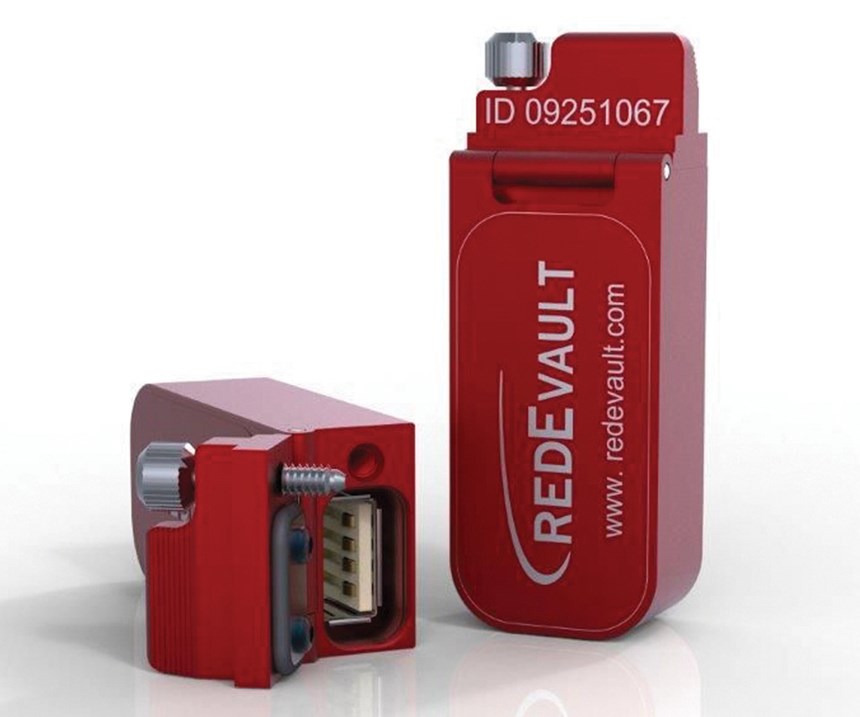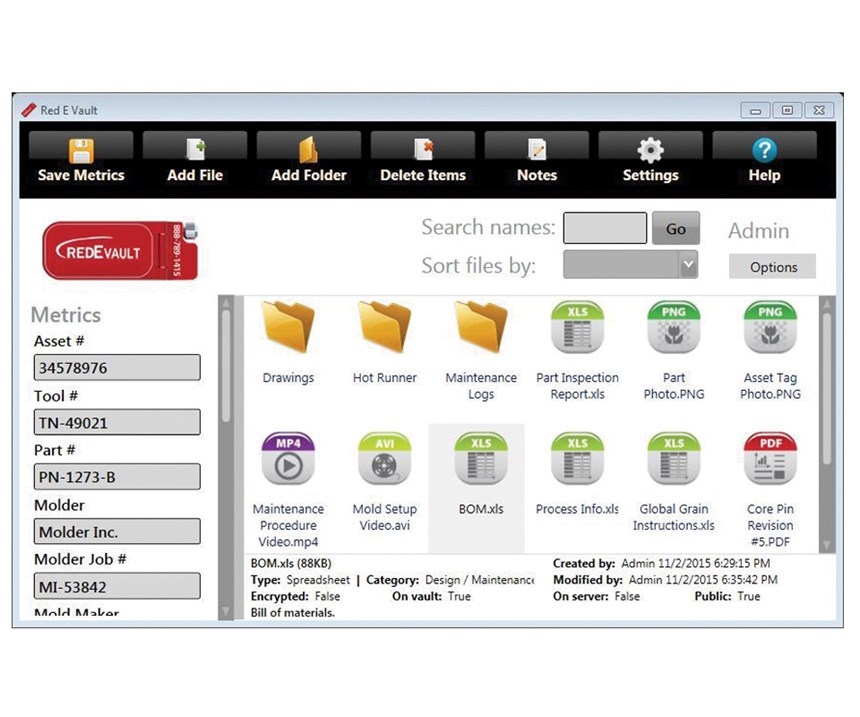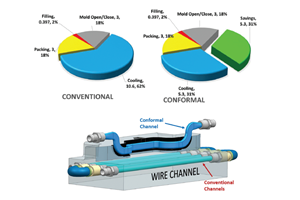Device Stores and Manages Data Directly on Mold
Data-driven manufacturing is becoming more and more prevalent in the moldmaking industry, but not all moldmakers have standards in place or the structure to maintain pertinent collected data after a mold is built and delivered.
Data-driven manufacturing is becoming more and more prevalent in the moldmaking industry, but not all moldmakers have standards in place or the structure to maintain pertinent collected data after a mold is built and delivered. Yet, there is unquestionably a need for that data at several stages of the mold’s lifecycle, most obviously when preventive maintenance and repairs are required. To ensure important mold decisions are never left to guessing, TS Tech Americas installs a Red E Vault on-board data storage system from Red E Innovations LLC on every mold it builds.
But it wasn’t always this way.
The global company, which is based in Reynoldsburg, Ohio, but has roots in Japan, manufactures seats and interior components for automobiles, recreational vehicles and motorcycles. According to Justin Crawford, product development engineer, the automotive industry requires that molds for service or aftermarket parts be maintained even after mass production of the vehicle stops, but things can and often do happen along the way to disrupt the status quo.
Three years ago, TS Tech was tasked with refreshing the design of the seating assembly of a pickup truck that was first introduced more than 10 years earlier. Eighteen of the 21 existing molds would be carried over to the new vehicle model, but Crawford says those molds desperately needed major repairs and refurbishment, including flash repair, and replacement or re-machining of vent channels, sleeves, bushings, water line fittings, date wheels and grids, as well as water line inspection and cleaning. All of this had to be done before the molds could once again mass-produce acceptable parts. “The shops that were contracted to do the repairs requested data or a BOM (bill of materials) for each mold, and that’s when a big problem came to light,” he says. “After spending some time researching the molds, we learned that the original toolmaker, the original molder and the second molder all went out of business. The tools had been moved to new molder locations, but only the physical tools were moved. No data or drawings could be located.”
The contracted repair team began the arduous process of scanning lifters and slides, and using optical comparators and micrometers to manually measure worn-out mold components. The team also had to re-spot parting lines, and check vent channels and seals to prepare the molds for production. “It took about three months to complete the reverse engineering, recreate the data and get the molds production-ready,” Crawford says.
TS Tech first learned about the Red E Vault on-board data storage system at Amerimold 2010 and realized that, to prevent this scenario from ever happening again, it would be a good idea to keep all data about a mold with the mold itself. However, thinking the jump drive should be removable (with the Red E Vault, it is not), Crawford says it was decided that installing one drive in a pocket machined in each mold and plugging the pocket to secure it would make it easy for molders to access important data while also keeping costs down. “But when a molder took all of the jump drives out of the molds for ‘safeguarding’ and ended up losing them instead, we knew we had to find a better way. That’s when we contacted Red E Innovations about the Red E Vault,” he says.
While competing devices were considered, Crawford says benchmarking of the options proved that the Red E Vault was the best fit for several reasons, including its 16-GB storage capacity, which was significantly more than the others offered; its sturdy construction; and the fact that it doesn’t require installation at the parting line, where it could get cracked or crushed. The fact that it does not require batteries to operate was also a plus, he says.
Solid and Secure
“The Red E Vault, to me, is basically a USB storage device on steroids,” Crawford says. It is compact, measuring 0.620 by 0.990 by 2.660 inches, and its housing is made of aluminum, which helps protect it from heat, and oil and water contamination, and makes it resistant to vibration as well as magnetism. Each device comes with a USB cable and has a unique ID and security code. He says he particularly likes that the internal printed circuit board is protected by a gasket-clad lid that is secured with a panel screw so the screw head can’t be lost when the USB port is accessed. A tamper-evident aluminum tag covers the mounting screws to deter removal of the unit from the mold.
The device’s pre-installed Windows-based software offers three levels of file security, safeguarding intellectual property while still granting flexible access to an array of users. TS Tech maintains “administrative access” for all of the molds that it builds. Administrators who have the required password can see and manipulate all files, metrics or settings that have been loaded into the system. Moldmakers are assigned “standard-user” access and are permitted to add and view files approved by TS Tech, but cannot edit or delete them. Molders are assigned “public access” that allows them to open designated files without a password.
Easy Setup
When TS Tech first started using the device, Red E Innovations worked with the company to configure its desired settings within the software portal. The company uses this portal to tell its moldmakers what data needs to be uploaded to each Red E Vault device. Crawford says the process is very easy and logical, and offers many options. For example, he typically configures a list of metrics such as part number, part name, tool weight, resin type and shrink rate, and establishes general storage formats including email settings, public/user account permissions, file and note access options, and data-retention options. These settings on an individual device are then exported to the Red E Vault portal and assigned a password. Crawford also then can set other options like logos and links. Moldmakers order the devices as needed, using the file name, password, ID number and security code that Crawford assigns to access the needed profile. The Red E Vault then connects to the portal and downloads and configures all of the settings.
To ensure that the most updated data are downloaded, a unit is not installed on a mold until just prior to final shipment to the customer, Crawford says. “Future changes to processes or part designs can be documented and saved to the unit on location by anyone with the necessary permissions.
Crawford says TS Tech has installed more than 200 of the Red E Vault systems on both injection molds and stamping dies it has built. “Feedback about the device from our molding suppliers has been extremely positive,” he says. “They tell us how easy it is to use and that it saves a lot of valuable time during setups and maintenance. We no longer receive urgent email or calls from them asking for ejector pin sizes when one breaks, or mold drawings or maintenance instructions. Considering how easy it is to lose, delete or corrupt data, it’s comforting to know that everything is safely backed up and stored with every mold.”
Related Content
What You Need to Know About Hot Runner Systems and How to Optimize Their Performance
How to make the most out of the hot runner design, function and performance.
Read MoreHow to Overcome Complex Mold Texturing Problems
Key benefits when considering laser technology for mold texturing and repair.
Read MoreHow to Use Thermal Management to Improve Mold Cooling
A review of common mold cooling issues and possible solutions, including 3D printing applications.
Read MoreWhat is Scientific Maintenance? Part 2
Part two of this three-part series explains specific data that toolrooms must collect, analyze and use to truly advance to a scientific maintenance culture where you can measure real data and drive decisions.
Read MoreRead Next
How to Use Continuing Education to Remain Competitive in Moldmaking
Continued training helps moldmakers make tooling decisions and properly use the latest cutting tool to efficiently machine high-quality molds.
Read MoreAre You a Moldmaker Considering 3D Printing? Consider the 3D Printing Workshop at NPE2024
Presentations will cover 3D printing for mold tooling, material innovation, product development, bridge production and full-scale, high-volume additive manufacturing.
Read MoreReasons to Use Fiber Lasers for Mold Cleaning
Fiber lasers offer a simplicity, speed, control and portability, minimizing mold cleaning risks.
Read More













.jpg;maxWidth=300;quality=90)











